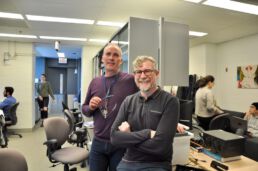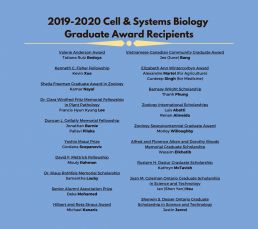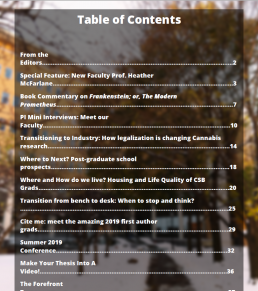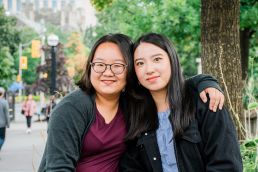CSB researcher awarded Provost’s Postdoctoral Fellowship
We are pleased to announce that Dr Ian Tobias has won a Provost’s Postdoctoral Fellowship to pursue research at Professor Jennifer Mitchell’s laboratory in Cell & Systems Biology. He will study how growth of stem cells differs between species.
Dr Tobias will examine regions of DNA called enhancers that can turn genes off and on without changing the protein they control. The evolution of new traits between species is known to mainly occur by alterations in regions of DNA (including enhancers) that are found outside of genes. He will determine whether activators that bind to enhancers have changed as animals evolved into different species, and how this affects the development of stem cells into the organs of the body. This follows on from his PhD work, where Dr Tobias demonstrated that the signals in the cellular environment that support stem cells are different in dogs compared with mice and humans.
This research has important implications for using stem cells to treat humans using regenerative medicine; with many stem cell studies conducted in worms, fish or mice, it is important to understand differences between species to unlock potential stem cell therapies for humans.
The goal of the Provost Postdoctoral Fellowship is to increase opportunities for hiring postdoctoral fellows from underrepresented groups, specifically Indigenous and/or Black researchers, and strengthen the research environment at the University with diverse perspectives. Dr Tobias is a member of the Chippewas of Nawash First Nation.
Prof Vince Tropepe's lab using zebrafish as a vertebrate model for Usher Syndrome-linked blindness
CSB Chair Vincent Tropepe has received funding from Fighting Blindness Canada to conduct research using zebrafish to study Usher syndrome, a genetic condition that results in hearing and vision loss. Loss of vision in Usher syndrome is the result of retinal degeneration, but the mechanism through which degeneration happens in unknown.
Clues to the way retinal degeneration happens in Usher syndrome can be found in the zebrafish model organism. The gene that is altered in 20% of humans with Usher syndrome is also present in zebrafish, and mutations in zebrafish that mimic the Usher-linked changes in this 'protocadherin' gene can result in reduced hearing and vision.
When the zebrafish protocadherin protein Pcdh15b is mutated in the lab, the integrity of the outer segment of retinal cells, the region that captures light, is compromised. Mutants have a progressive loss of photoreceptor outer segments, which can be attenuated by darkness or exacerbated by light exposure.
The Tropepe lab will characterize the subcellular defects that underscore photoreceptor degeneration, identify Pcdh15b-binding proteins to reveal novel Pcdh15-dependent mechanisms for photoreceptor maintenance, and catalogue the different forms of Pcdh15b to identify ones that will prevent retinal degeneration as a potential gene therapy.
We are grateful to Fighting Blindness Canada for their support; you can read more about their funded research and also donate to them here.
CSB neurobiologists identify switch that turns muscles on and off during sleep
CSB Professor John Peever, CSB PhD grad Zoltan Torontali and CSB RA Jimmy Fraigne have demonstrated a new link between arousal and muscle paralysis in mice using behavioral, electrophysiological, and chemogenetic strategies in a paper in Current Biology.
During REM sleep, muscle paralysis is induced by a region of the brain called the Sublaterodorsal Tegmental Nucleus (SLD). Involuntary muscle paralysis during wakefulness can occur in the natural phenomenon of cataplexy, whereas sleep is involuntarily induced in narcolepsy.
Prof Peever’s lab found that activation of SLD neurons in both narcoleptic and normal mice promotes cataplexy, whereas SLD silencing prevents cataplexy. This region of the brain therefore couples arousal state and motor activity during REM sleep and wakefulness.
This new understanding has the potential to treat muscular disorders in humans. In Parkinsons’s disease, the affected person’s muscles are in a continual state of rigour during wakefulness, but this rigour relaxes during REM sleep. Prof Peever dreams of helping Parkinson’s patients by applying this new understanding of the SLD to tune their muscle tension during wakefulness.
You can read more about this insight in a story from UofT News and in the Current Biology paper.
Neuroscientist Dr Jessica Pressey joins CSB in 2020 as Assistant Professor, Teaching Stream
We are fortunate to have recruited Jessica Pressey to CSB as an Assistant Professor, Teaching-Stream (3-year CLTA) as of Jan 1, 2020. Professor Pressey graduated with a PhD from Dean Woodin's lab in 2015 and completed postdoctoral research at INSERM's Institut du Fer à Moulin in Paris, France.
Her field of expertise is synaptic transmission, neuroplasticity, and brain development and as such she will be a valuable addition to CSB's Animal Physiology Major program and for CSB research project course students studying electrophysiology.
Congratulations, Professor Pressey!
Researchers delay onset of amyotrophic lateral sclerosis (ALS) in laboratory models
Learn more about recent research from the laboratories of Prof Junchul Kim and Dean Melanie Woodin, "Cortical interneuron-mediated inhibition delays the onset of amyotrophic lateral sclerosis", in this story from the Faculty of Arts & Science:
Researchers delay onset of amyotrophic lateral sclerosis (ALS) in laboratory models
Pan-genome effector analysis of Pseudomonas syringae reveals the ways wild plants evade infection
The Guttman and Desveaux labs in Cell & Systems Biology have published a comprehensive analysis of the huge variety of methods used by bacteria to evade the immune system of plants in the latest issue of Science magazine: "The pan-genome effector-triggered immunity landscape of a host-pathogen interaction."
Imagine you're growing a tomato plant and you see black spots on the leaves and fruit. This could be a bacterial infection. You notice that a weed that's growing beside it in your garden doesn't have the black spots even though it's touching the infected areas. This is due to resistance genes (R-genes) in wild plants that give it immunity to infection by the black spot bacteria.
Professors Desveaux and Guttman's goal was to survey all the different ways that one species of bacteria can try to evade the immune response in plants. Working with post-doc Dr Marcus Dillon and graduate students Bradley Laflamme, Alex Martel and Renan Almeida, they collected together over 500 different effectors used to infect plants from all variants of the bacterial species Pseudomonas syringae. By exposing the wild plant Arabidopsis thaliana to this comprehensive library, they identified all the R-genes that are stimulated by these effectors, including two new ones.
Although crop plants like tomatoes have resistance to many infections, they may have lost some R-genes through breeding programs that selected for traits desired by humans. Those R-genes may still be active in wild or heirloom varieties of the plant. To apply the discoveries made in their Science paper, the Guttman and Desveaux labs have received funding from the Weston Foundation Seeding Food Innovation program to identify and reintroduce missing R-genes into crop plants.
More details on these tools for combating crop diseases are shared in this UofT News story
Graduate student excellence recognized in the 2019-2020 Graduate Student Awards
The academic excellence, research potential and leadership abilities of Cell & Systems Biology graduate students was recognized in award presentations at the 2019 CSB Holiday Party held in the Madison Avenue Pub on December 6th, 2019.
Professor Dinesh Christendat announced the recipients of a number of prizes, scholarships, fellowships and awards. Through the generosity of private donors and matching funds from the University, a substantial number of endowments have been established to provide these internal awards to CSB graduate students. Many of these awards are provided as a top-up to the student’s base stipend.
Congratulations to all the graduate students who were granted these acknowledgements of their hard work, persistence and eloquence!
The CSB Forefront is a fascinating digital magazine produced by CSB graduate students
The inaugural volume of Cell & Systems Biology's graduate student newsletter is out! The CSB Forefront covers many aspects of life in grad school. Faculty profiles give insights into what motivates CSB professors. Graduate student life is covered in housing profiles, lifestyle surveys and book reviews. Conference presentations and research publications from CSB labs are celebrated. There are articles on finding jobs after graduation and new initiatives to boost your career profile.
Chief editors Francis Lee and Tatiana Ruiz Bedoya drive this project with the objective of strengthening CSB's sense of community by celebrating student achievements and by discussing shared interests and struggles. The CSB Forefront also provides a safe and inclusive platform for graduate students to share their ideas and experiences. In this spirit, the Forefront team is always looking for a graduate student who wants to express their ideas either via text or visuals. If you have something you would like to share with our community, contact details are in the newsletter!
CSB397 Research Abroad course provides new skills and new experiences
Our undergraduate CSB397 course provides the opportunity to conduct scientific research in academic labs around the world. In 2019, we had 17 students going to Singapore (NUS), Japan (Riken), Denmark (Copenhagen), Germany (Konstanz), Scotland (Strathclyde) or England (City). Upon returning to Canada, students present a final report or poster to the Department describing the results of their experiments.
CSB students Echo Jing and Stephanie Le agreed to share their experience as research students in Singapore. They highlight the experiential learning opportunity provided by the course: “This was the first time I’d worked in a molecular cellular lab,” Echo says. “I learned experimental research techniques and that gave me insight into what a real molecular cellular researcher does in a real lab setting. I also learned how to approach problems critically as a researcher.”
More details on CSB397 can be found under International Experience on the CSB website. Entry to this course is limited, and the deadline to apply for Summer 2020 is December 3, 2019.
Innovative App development leads to an e-learning award for Professor Melody Neumann
Congratulations to CSB Professor Melody Neumann, who competed in the eLearning Excellence Awards at the European Conference on e-Learning in Copenhagen. Her project Team Up!: The use of Student Teams in Online or Large Hybrid Classes Improves Course Outcomes won 2nd prize!
Team Up! is an online learning tool that facilitates active learning and group work. Initially she developed this app for virtual breakout rooms in CSB201, an online course intended to provide non-science students with an understanding of basic concepts in molecular biology and genetics.
Team Up! is now in use in ten courses across different Faculties through the University’s online teaching and learning environment Quercus. Students can collaborate in Quercus groups, or spontaneously form their own groups. This provides the opportunity for peer teaching and consensus-building, while allowing misconceptions to be corrected immediately.






